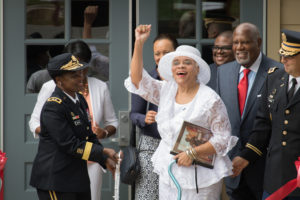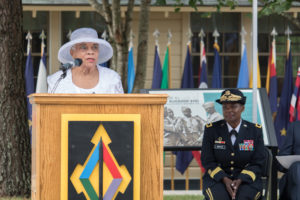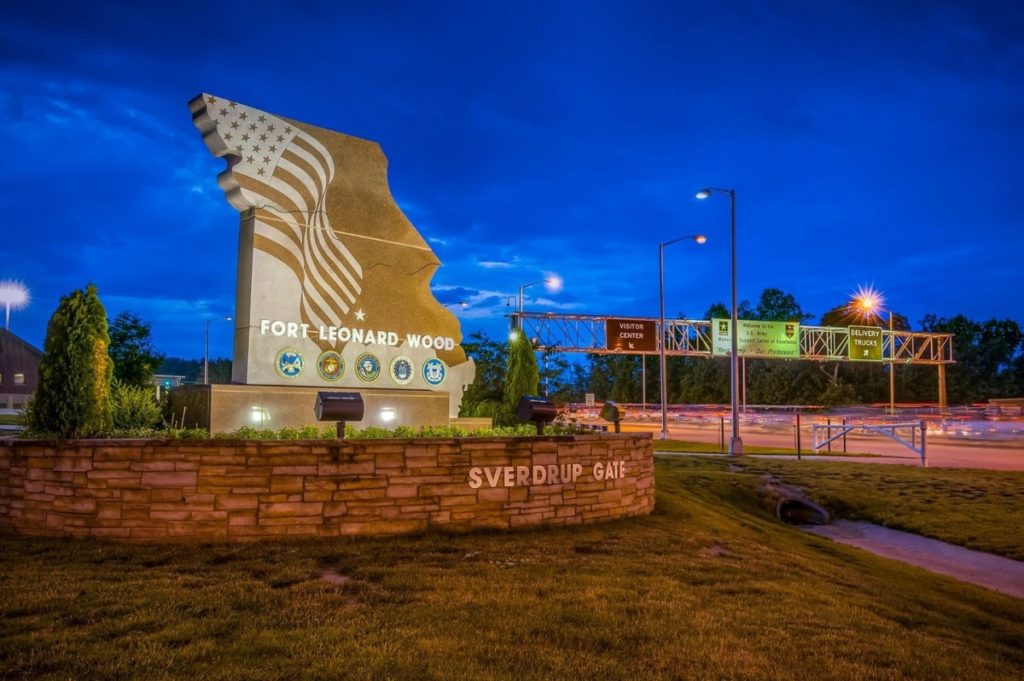Sam Campbell
FORT LEONARD WOOD, Mo., Aug. 13, 2019 – After more than a year of renovations, Fort Leonard Wood’s Building 2101, or better known as the Black Officer’s Club, was memorialized and renamed today in honor of the late artist Staff Sgt. Samuel Countee, who painted the building’s recently-restored mural 74 years ago.
Maj. Gen. Donna Martin, commanding general of the Maneuver Support Center of Excellence and Fort Leonard Wood, cut the ribbon alongside other officials and special guests, including Countee’s niece and namesake, Sammie Witing-Ellis.
“Today, (Countee) is the giant on whose shoulders we stand and I could not be more honored than to be a part of the dedication of this hall in his name, and in honor of all the service and sacrifice of his contemporary service members on whose shoulders we stand,” Martin said before officially declaring the building Staff Sgt. Samuel A. Countee Hall.
“History intersects at Fort Leonard Wood and starting today, the 82,000 service members and civilians that train here each year can use this renovated classroom and meeting space to learn,” Martin said.
Witing-Ellis was instrumental to the identification of the mural more than 20 years ago when she found a matching piece in her uncle’s sketchbook.
She spoke about the ceremony and her uncle, who she referred to as a spiritual and religious man.
“It’s a monumental day,” Witing-Ellis said. “It’s a landmark, especially for our family (and) the country, to finally recognize a person who contributed so much and who did so much to elevate what was happening at that time, especially to minority Soldiers as they were going forward to represent the country.”
She explained that Countee wrote narratives for most of his artwork, giving some insight as to why he depicted certain scenes. The mural in Countee Hall was a reflection of his observations and inner thoughts, she said.
“I think that it’s a wonderful preservation of something that encompassed his life and what he saw among his fellow Soldiers, who were here, far away from home, reminiscing (about) family but at the same time, knowing that if and when they came home, they could refer back to a peaceful time — a time of caring and sharing,” Witing-Ellis said.
The mural remains inside a protective glass case atop the original stone fireplace in the newly named Countee Hall.
During the building’s renovations, the mural was on display at the installation’s John B. Mahaffey Museum Complex, giving the public a rare glimpse at the historic piece.
Officials from the Fort Leonard Wood Directorate of Public Works believe the mural to be the only surviving artwork from Countee’s time in the military. He was stationed at Fort Leonard Wood in the 1940s.
Former Director of the National Park Service Robert Stanton attended the ceremony and offered remarks on its historical relevance.
“The preservation of this magnificent building and certainly the restoration of the mural is fully in keeping with the letter and spirit of the National Historic Preservation Act (of 1966),” he said. “To that point, I want to commend the leadership of Fort Leonard Wood and all the consulting parties, and certainly including Ms. Sammie Ellis, for the project and how it has been fulfilled today.”
He commented on the event’s significance and the Army’s past segregation, which ended July 1948 through executive order by President Harry Truman.
“The African-American Soldiers stationed here – they overcame some strong difficulties and yet they contributed to the freedom and the privileges that we enjoy today,” Stanton said. “That is really the ultimate lesson learned, that while we are confronted with some difficult periods in our history, individually (and) collectively, that if we have the will, we can overcome it.”
Stanton said he wants future visitors of the building to walk away with a broader understanding of their role in preserving history.
“I hope that the people take from here back to their respective communities and respective organizations that all of us share responsibility in contributing to the preservation of our collective heritage,” he said.
In 2014, the 3rd Chemical Brigade set out to save the Black Officers’ Club from possible demolition due to its vacancy.
Several aspects of the building underwent renovation, including the restoration of its original stonework that was laid by German prisoners of war in World War II.
To this day, some German symbols can be seen on bricks POWs laid around the fort.
Countee Hall is one of two Black Officers Clubs from World War II that still stands, Martin said.


-30-
About Fort Leonard Wood
Fort Leonard Wood is a thriving and prosperous installation that has evolved from a small basic training post more than 75 years ago to a premier Army Center of Excellence that trains more than 82,000 military and civilians each year.
Fort Leonard Wood is home to the U.S Army Maneuver Support Center of Excellence and three U.S. Army schools: the U.S. Army Engineer School; U.S. Army Chemical, Biological, Radiological, and Nuclear School; and the U.S. Army Military Police School. In addition to training engineer, CBRN and military police specialties for the Army, Fort Leonard Wood also provides gender-integrated in-processing and Basic Combat Training for new Soldiers.
Fort Leonard Wood also hosts and trains with the largest Marine Corps and Air Force detachments on any Army installation as well as a large Navy construction detachment.
More information about Fort Leonard Wood is at: https://home.army.mil/wood/index.php/about/mission


